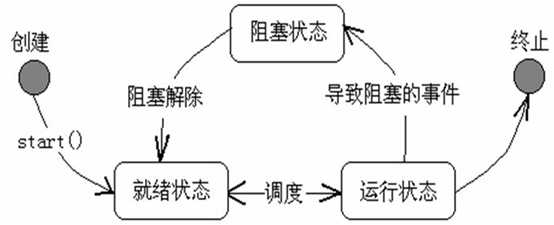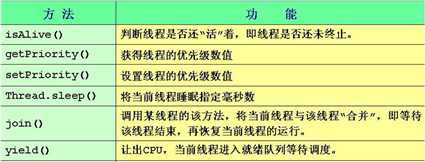标签:object string static running method 线程同步 rri cat override
进程:计算机在执行的程序的实体 例如:一个.exe文件,一个.class文件
线程:一个程序内部的顺序控制流
一个进程中可以包含一个或多个线程,一个线程就是一个程序内部的一条执行线索。
进程和线程的区别
1.每个进程都有独立的代码和数据空间,进程的切换或有很大的开销。
2.同一类线程共享代码和数据空间,每个线程有独立运行的栈和程序计数器,线程切换开销小。
多进程:在操作系统中能同时运行多个任务。
多线程:在同一个应用程序中有多个顺序同时执行。
1.继承Thread类
2.实现Runnable接口
1.Thread()
2.Thread(Runnable target)
覆盖run()方法
public class ThreadDemo extends Thread{ @Override public void run() { for (int i=0;i<10;i++){ System.out.println("Thread"+i); } } public static void main(String[] args) { ThreadDemo threadDemo=new ThreadDemo(); threadDemo.start(); } }
实现Runnable接口
线程共享同样的数据和代码,覆盖Runnable接口中的唯一的方法run()
1 public class RunnableDemo implements Runnable { 2 @Override 3 public void run() { 4 for (int i=0;i<10;i++){ 5 System.out.println("Thread"+i); 6 } 7 } 8 9 public static void main(String[] args) { 10 RunnableDemo runnableDemo=new RunnableDemo(); 11 Thread thread=new Thread(runnableDemo); 12 thread.start(); 13 } 14 }

start():使线程处于可以运行的状态,但不一定意味着该线程立即开始执行。
线程中主要的方法:

sleep():让线程终止一段时间的静态方法;Thread.sleep(long millis)------暂停执行millis毫秒;在睡眠起满的瞬间,再次调用该线程不一定会恢复它的执行。
join():导致当前线程等待,知道调用这个join方法的线程终止,
yield():为其它可运行的线程提供执行机会;静态方法----Thread.yield
自动终止:一个线程执行完成后,不能再次执行。
手动终止:
stop()
interrupt()
可通过使用一个标志指示run方法退出。
1 public class Runner implements Runnable { 2 private boolean timeToQuit=false; 3 @Override 4 public void run() { 5 while(!timeToQuit){ 6 // ………… 7 } 8 } 9 public void stopRunning(){ 10 timeToQuit=true; 11 } 12 private Runner runner=new Runner(); 13 private Thread thread=new Thread(runner); 14 15 public void starThread(){ 16 thread.start(); 17 } 18 public void stopThread(){ 19 runner.stopRunning(); 20 } 21 }
void wait():导致当前的线程等待,直到其它线程调用此对象的notify()方法会notifyAll()方法。
void notify():唤醒在此对象监视器上等待的单个线程。
void notifyAll():唤醒在此对象监视器上的所有线程。
为线程添加线程锁
锁定方法:synchronized void method(){}
锁定代码块:synchronized(Object){}
一旦一个包含锁的线程被cpu调用,其它线程就无法调用相同对象的锁定方法。当一个线程在一个锁定方法内部,所有试图调用该方法的同实例的其它线程必须等待。
同步方法
1 public class Testsync implements Runnable { 2 Timer timer=new Timer(); 3 @Override 4 public void run() { 5 timer.add(Thread.currentThread().getName()); 6 } 7 public static void main(String[] args) { 8 Testsync testsync=new Testsync(); 9 Thread thread1=new Thread(testsync); 10 Thread thread2=new Thread(testsync); 11 thread1.setName("1"); 12 thread2.setName("2"); 13 thread1.start(); 14 thread2.start(); 15 } 16 }
1 public class Timer { 2 private static int num=0; 3 public synchronized void add(String name){ 4 num++; 5 try{ 6 Thread.sleep(1); 7 }catch (Exception e){ 8 9 } 10 System.out.println(name+"你是第"+num+"个线程"); 11 } 12 }
同步代码快
1 public class Testsync implements Runnable { 2 Timer timer=new Timer(); 3 @Override 4 public void run() { 5 timer.add(Thread.currentThread().getName()); 6 } 7 public static void main(String[] args) { 8 Testsync testsync=new Testsync(); 9 Thread thread1=new Thread(testsync); 10 Thread thread2=new Thread(testsync); 11 thread1.setName("1"); 12 thread2.setName("2"); 13 thread1.start(); 14 thread2.start(); 15 } 16 }
1 public class Timer { 2 private static int num = 0; 3 4 public void add(String name) { 5 synchronized (this) { 6 try { 7 Thread.sleep(1); 8 } catch (Exception e) { 9 10 } 11 System.out.println(name + "你是第" + num + "个线程"); 12 } 13 } 14 }
注意:受到synchronized保护的程序代码快和方法中,要访问的对象属性必须设定为private,因为如果不设定为private,那么就可以用不同的方法来访问它。
标签:object string static running method 线程同步 rri cat override
原文地址:http://www.cnblogs.com/zhuxiaodong/p/6027364.html